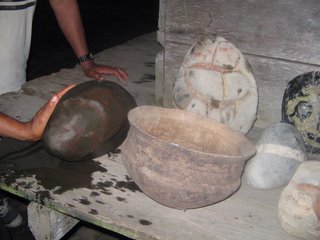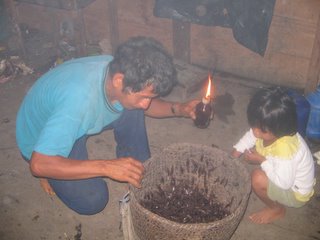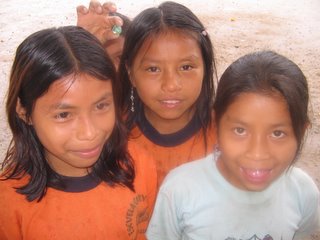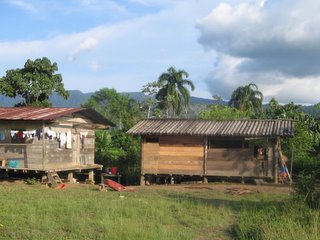Anna Michael - The future of Mushullacta
Mushullacta
Mushullacta is a Kichwa community situated in the Cloud Forest inbetween Galeras and the Sumaco national park. In order to get there it is necessary to travel to Tena and then from Tena there is one bus per day to a little village called Papanku. The bus journey is very uncomfortable but the view is breathtaking. Halfway into the journey we had to stop at the side of the road as a mine further up was blasting. Once you arrive in Papanku (a few shacks in the middle of nowhere) you will have to walk for two hours along a very bad dirt road. The bus arrives in Papanku quite late so it’s normally pitch black and you can’t see much but you can hear the sounds of the forest around you.
Mushullacta
There is a small path that veers off to the right from the main path up a steep hill that leads to Mushullacta. The village consists of several houses surrounding a large field. At the opposite end of the field is the school, which is a large building consisting of three classrooms. Estella and her family live in the house closest to the path to the main road. They have a wooden house where they sleep, which also has a small shop where they sell sweets, drinks, eggs and cigarettes. On one side of the house is a separate room where volunteers sleep. The family also have another house where they cook and eat. This is where they spend a lot of their time. The kitchen consists of a few gas stoves and a place to wash their dishes. Next to the kitchen is a large fire, which they sit around. The fire is used to cook fish wrapped in leaves as well as to ward away insects. Also in the same house as the kitchen is a small dining table where Estella and her mother will sometimes feed the men that are currently living in the community that work for the government improving the road.
Daily Life
The day normally begins at about 4:30am when the women get up, re-build the fire and start preparing the breakfast. Breakfast is normally rice and eggs with or without fried or boiled bananas but can consist of any of the food they eat, there is no distinction between food for breakfast and food for dinner. The people in the community take it in turns to feed the men that work for the government improving the road. At about 7am the men go off to work on the road with the men from the government. The men from the government have diggers and tractors whilst the men of the community work with machetes clearing the plants and trees from the edges of the road. The people in the community are currently working very hard so that the road will soon be good enough for buses to reach the village. This will greatly improve their lives as it will make it a lot easier to get food supplies and to travel into Tena or Archidona where several family members live. Whilst the men work on the road the women of the village take large pots and pans and food down to the side of the road and cook large pots of rice, chicken, spaghetti, fish and vegetables depending on what they have. They spend all day cooking, chatting and laughing until the men come for lunch. After this the women wash all of the pots and pans in the river, which is half an hour from the village and carry everything back to their houses. The rest of the day is spent washing clothes and cooking food for dinner. The men normally finish work at about 4pm y which time, due to all of the chicha they have been drinking many of them are very drunk. This is very normal and the women do their best to stay out of their way and ignore them.
The people of Mushullacta currently have a lot of aspirations and are working on several projects. They managed to acquire funding from the government to build toilets for each family in the community. The toilets are housed in concrete cubicles and consist of proper western style toilets but without a flush. They put water down the toilet to clear it. There are currently only a few of these toilets in the village but there is material to build more once work on the road has been completed.
Another large project the whole community is working on is the construction of a tourist cabaña a short walk from the village. They have already constructed the framework for the cabaña and it already has three toilets. Unfortunately they will have to rebuild the roof as it has become infested with ants.
Leonidas, the brother of the president of Mushullacta is very keen to improve the village and is currently working on clearing all of the rubbish that everyone in the village just throws on the ground and in the river. They have dug large holes in the ground where they will put all rubbish in the future before covering it over. It is not a perfect solution but it is better than the current situation. They are also attempting to develop compost using all of their organic waste but this project is still in it’s infancy.
The community also grow maize, bananas, narajillas, yucca and pineapples amongst other things in both large communal gardens and in private family gardens behind their own houses. Whilst I was there I helped create a garden solely for medicinal plants.
The community also have a large concrete building, which will eventually house computers, although the village does not currently have electricity.
The village is situated approximately 30-40minutes away from the river and because of this a few years ago they constructed system of pipes that brings water to the village in several locations for bathing, drinking water and for washing clothes.
The School
Classes are generally held from Monday to Friday from 7:30-12 in the school. Children come from other villages as well as from Musullacta. Most of the children wear a uniform consisting of a bright orange t-shirt with the school emblem and navy blue trousers for the boys and a skirt for the girls. There are three teachers that are paid by the government. They teach ages 5-6yrs, 7-8yrs and 9-12yrs. The children learn maths and Spanish amongst other subjects and are very keen to learn. There is normally a break at about 10:30am when government issued biscuits are handed out and the children are also usually fed a meal of rice, lentils and tuna at some point during the school day. Women from the village take turns to cook the food. The children eat in a separate building next to the school. The youngest children do not speak much Spanish as their primary language is Kichwa.
Volunteers are expected to teach English to all of the children. Depending on the consistency of the teaching the children respond quite well with the exception of the very youngest.
Estella’s Family
Estella is the daughter of Juan a brother of Leonidas. She has a 2yr old daughter Shandi, who is adorable. Estella lives with her mother, father, brother and niece, 5yr old Marina, whose mother lives in Cayambe. Estella’s family looks after the volunteers.
Leonidas lives with Jose (the president of the community) in a separate house opposite the school. Jose and Leonidas also play traditional Kichwa music using a guitar, flute and pipes. Their father was also the Shaman of the village so Leonidas is very knowledgeable about the medicinal properties of the plants that grow in the rainforest there.
The future
The future for Mushullacta is bright as the community are working together to improve many aspects of their life. Once the road is finished they will have much better access to the other communities as well as the nearby towns instead of having to walk several miles before getting on the only bus.
The people need help understanding how to deal with the transition into modern life. Interaction with the western world has brought many problems including the introduction of sweets, fizzy drinks and biscuits, which are rotting the teeth of the children and creating rubbish. Simple lessons in hygiene such as learning the importance of brushing their teeth regularly, not giving children so many sugary drinks and sweets and not to throw rubbish on the floor or in the river would be a great start.
The people of Mushullacta are very proud of their culture and heritage and are working hard to protect the environment in which they live in. They are keen to teach other people about their way of life but also keen to learn how to improve it. The surrounding area is very beautiful but it is still under threat and the people of Mushullacta need our help to protect it.
To see photos from Mushullacta:
www.offexploring.com/annamichael photographs/Mushullacta





